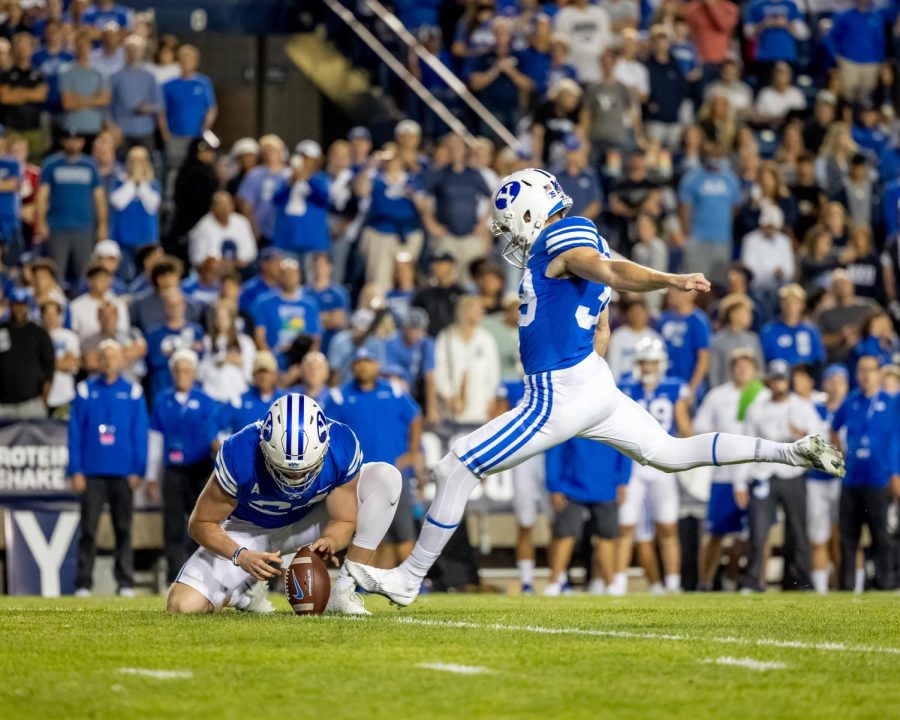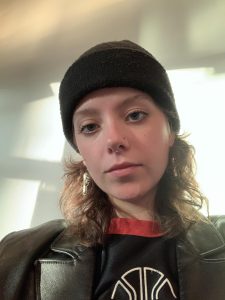Jarvis: Stop Letting Fans at Utah Sports Events Get Away With Racism
BYU’s Jacob Oldroyd (39) and Ryan Rehkow (24) in the game against University of Utah Utes at the LaVell Edwards Stadium in Provo, Utah on Sept. 11, 2021. (Photo by Jack Gambassi | The Daily Utah Chronicle)
February 23, 2023
Utah has a history of racism during sports events. Following the recent news of students in the stands being racist towards athletes during a basketball game at Roy High School, I looked into other similar incidents in Utah.
Racism happens at all levels of Utah sports. Utah Jazz fans have a racist reputation, the most well-known incident involving Russell Westbrook, a Utah Jazz player. In 2019, he stood up to a fan who hurled racist remarks at him during a game. Not only was he fined $25,000 by the NBA after the exchange, but he was also sued by the alleged racist fans for $100 million, though the lawsuit was later dismissed by a judge.
And last August, Rachel Richardson, a volleyball player at Duke University, reported that fans had yelled racial slurs at her from the stands at Brigham Young University. She wrote that “officials and BYU coaching staff were made aware of the incident during the game, but failed to take the necessary steps to stop the unacceptable behavior.” Soon after, soccer players from USC spoke up about a similar situation that happened last year, also at BYU.
The lack of consequences for racist fans and tendency for people to deny allegations of racism occurring at sports events in Utah is unacceptable. It indicates Utahns’ indifference towards the recurring negative experiences of athletes of color.
School administrators typically have no problem ejecting people from sports games. In Jan. 2020, Laval Stephens, a Black junior varsity basketball player, was treated cruelly by authorities during his team’s game. He was watching the game on the opposing side of the stands with other teammates when a school administrator asked him to leave. As he was walking to his team’s side of the gym, a Utah County Sheriff’s department deputy claimed the player was trespassing. He pushed Stephens outside the building and handcuffed him.
This is a clear example of an athlete experiencing racism, but this time, the person experiencing racism was kicked out of the game. If officials can do this, they should logically have no problem kicking out racist fans. But racism is not taken as seriously as it should be, and biased officials choose who merits removal from games.
During one occurrence last February, officials did enforce removal for racist behavior. Two Salem Hills high school students were escorted out of a basketball game after making racial taunts toward players. Yet a similar incident occurred at a Salem Hills soccer game half a year later.
For every case of reported racism in sports games, there are some who refuse to believe it or demand further evidence. A month after the BYU volleyball match, BYU concluded that there was no proof, apologized to the accused fan and removed the ban they had previously placed on them.
Commenters on the KSL story about the Salem Hills soccer incident invoke the term “innocent until proven guilty.” Others use the BYU incident as proof of false allegations that will surely be “debunked.” A lack of clear evidence does not mean the racism did not happen.
Racism isn’t rare in Utah, and it’s dangerous to deny that. As of 2022, 77.2% of the Utah population is white, compared to the 1.5% made up of Black people. Despite these numbers, Utah police shoot at minorities at alarmingly high rates. In Davis School District, “serious and widespread” racial harassment went ignored for years. Furthermore, it’s no secret that the LDS church, Utah’s dominant religion, has racism embedded in its very doctrine. Thus, it’s unsurprising to see racism at BYU, a private LDS university.
The sportsmanship policies of the NCAA and UHSAA do not make room for such racism. The University of Utah has similar fan behavior guidelines. Whether the bias is based in religious beliefs or not, the guidelines must always be enforced. When officials are made aware of racism, it is crucial that they act immediately to identify and remove the racist attendees. If current officials will not enforce this, they should be replaced. Other fans in the stands can easily find out who the offenders are and should pay attention, alerting officials or security when needed.
On Monday, Feb. 13, KUTV released an article outlining the conclusion of the investigation after the recent incident at Roy High School. The district imposed a ban on taunts and animal sounds from the crowd, moved the student section farther away in the stands and increased the number of staff for monitoring. This is a good example of action being taken, although it was not reported that the students were identified or disciplined in any way.
The amount of racism that we have seen in the past year in Utah sports events alone is disgusting. This news from Roy High School is no different. Athletes should be able to focus on their sport without being barraged with racism.









